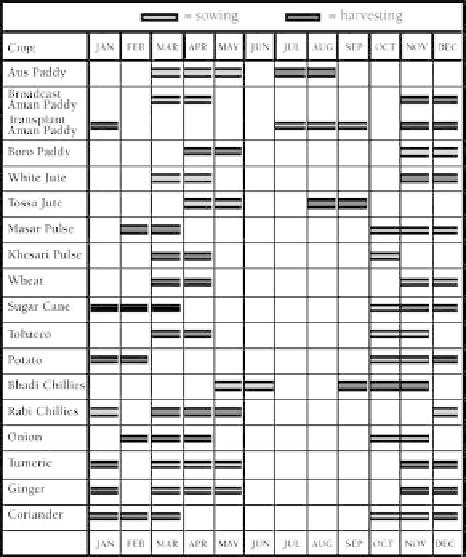Geography Reference
In-Depth Information
not suited to flood conditions. Consequently , high-
yielding rice is limited to
rabi
or dry season and other
varieties are planted for the rain-fed and flooded
kharif
.
Bangladesh must import food to meet the needs of its
ever-growing population.
Given climatic factors and the limited availability of
irrigation facilities and fertilizer, most of Bangladesh is
limited to one crop a year. About 40 percent of the land
can be double-cropped and 8 percent triple-cropped.
Recent efforts to diversify have seen regional special-
ization. Virginia tobacco is grown in the north, and the
Sylhet region in the northeast produces 94 percent of the
nation' s tea. Harvested nine months a year, exported tea
is an important earner of foreign exchange. Rubber and
coffee are concentrated in the CHT .
With the installation of tube wells, high-yielding
wheat has become prominent in the north, with yields
exhibiting a ten-fold increase between 1970 and 1983 and
subsequent significant increases ever since. However, in
much of Bengal overuse of tube wells is drawing arsenic
from pyrite bedrock into the water system. In Bangladesh,
between 40 and 60 million people are developing symp-
toms of arsenic ingestion. This causes ever-worsening
skin lesions, various cancers, and leads to death. The
World Health Organization calls this the largest mass poi-
soning in human history .
Fiber crops are critical to the Bangladeshi economy
(Figure 9-5). For instance, two-thirds of all the manufac-
turing jobs in the country are related to the cotton indus-
try . Second to rice in terms of acreage is
jute
, a fiber crop
used for sacking, twine, rope, carpets, car interiors, and
lining for asphalt. Green jute is finding increasing use in
Figure 9-4
Agricultural calendar . Note that June and July are the least busy
months. Why do you think this is?
in the context of variation in water levels. These include
deep-water types that grow in 15 feet (5 m) of water. This
rice is harvested from boats.
Bangladeshi farmers produce a wide array of crops,
yet rice covers 80 percent of the cultivated area. Unfortu-
nately , the high-yielding rice of the Green Revolution is
Figure 9-5
These mats are made of coconut fiber (coir). The
picture was taken in Dhaka' s jam-packed down-
town.
Photograph courtesy of B. A. Weightman.



















Search WWH ::

Custom Search